Most exercises have rather literal names: A single-arm overhead dumbbell extension describes the movement pretty well, after all. A few others, however, are named for the part of the body they'll break if you lose control. In this class we have skullcrushers.
Skullcrushers are actually a family of single-joint triceps exercises, not necessarily just one exercise, because there are so many ways to do them. You can use almost any kind of implement—dumbbells, barbell, EZ-bar, or cables—as well as a variety of angled benches. Each variation provides a slightly different feel and effect, so I'll guide you through the most popular.
What all skullcrusher variations have in common is simple: elbow extension. The upper arms are generally locked in a position perpendicular to the body, which means both the long and lateral triceps heads—the two biggest—are called into play. As you increase the angle of the bench (i.e., use a more inclined bench), the upper arms move closer to an overhead position, so more of the work falls on your triceps long head. Doing the movement on a decline bench reduces the long-head involvement, so more of the emphasis falls on the lateral triceps head.
Tips for Crushing The Skullcrusher
There are a few important keys to doing the movement:
Keep your upper arms perpendicular to the floor, not necessarily perpendicular to your body. This ensures you're working against gravity. Your arms should automatically be perpendicular to your body when you're on a flat bench, but won't necessarily be when you're doing the movement on an incline or decline bench.
Only extend your elbows. Avoid allowing your upper arms to move back and forth from their position as you raise and lower the weight. If you move your arms, you put some of the load on your shoulders.
Lower the weight under control, which means using a weight you can safely handle. Use a very deliberate rep speed on the negative. I assume you know why! (If not, just reference the exercise name again.)
As you power the weight back up, stop just short of full extension so that you're unable to rest in the top position, which keeps tension on the muscle throughout the range of motion.
Use a spotter when training to failure. A spotter can also assist you with a few additional forced reps, hand you the weight to begin, or grab the weight when you're done.
Keep your elbows in tight as much as possible and avoid elbow flare to ensure the triceps do the bulk of the work. Allowing your elbows to flare out reduces the triceps' workload.
Common Skullcrusher Variations
With an EZ-Bar
Don't use a very close grip on a bar; take it with a grip of about shoulder-width. Using the EZ-bar can be more comfortable for your wrists, compared to a barbell, and the wider grip will be easier to balance in your hands and reduce elbow flare.
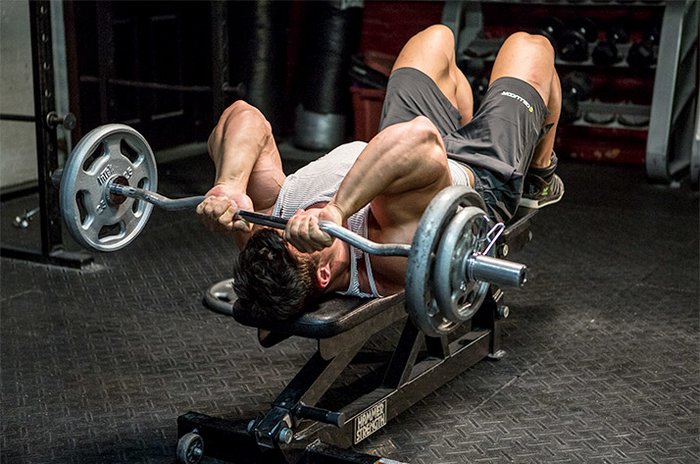
EZ-bar skullcrusher
Dumbbells
With dumbbells, each arm has to work independently. You'll sacrifice the amount of weight you can use, because dumbbells are harder to control, but that's not necessarily a bad thing. You're also able to perform these with different grips, which affects how the triceps are recruited.
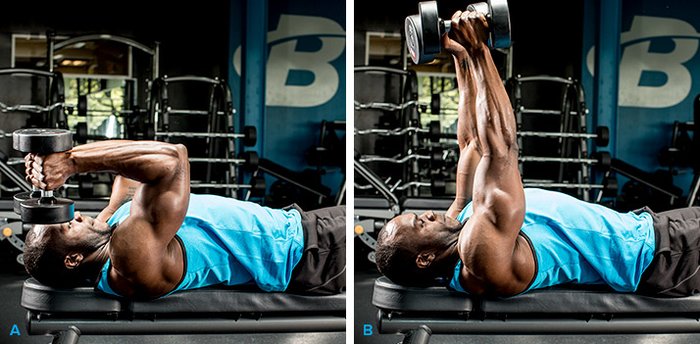
Dumbbell skullcrusher with pronated grip
Incline bench
This variation puts a bit more emphasis on the long head. Don't make the angle too steep.
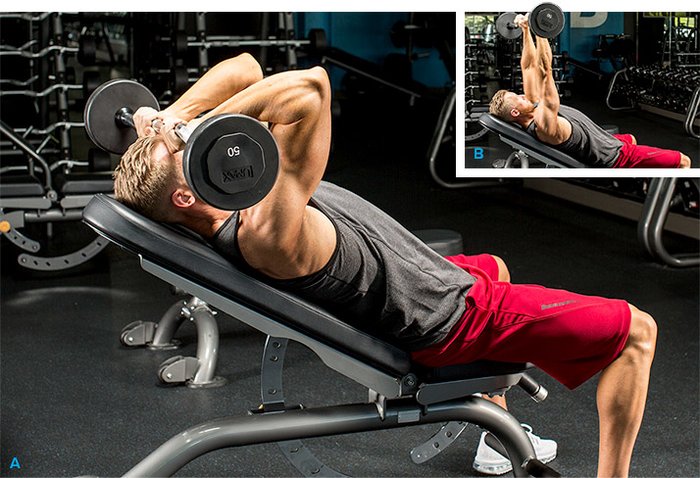
Incline EZ-bar skullcrusher
Decline bench
These crushers put more emphasis on the triceps lateral head.
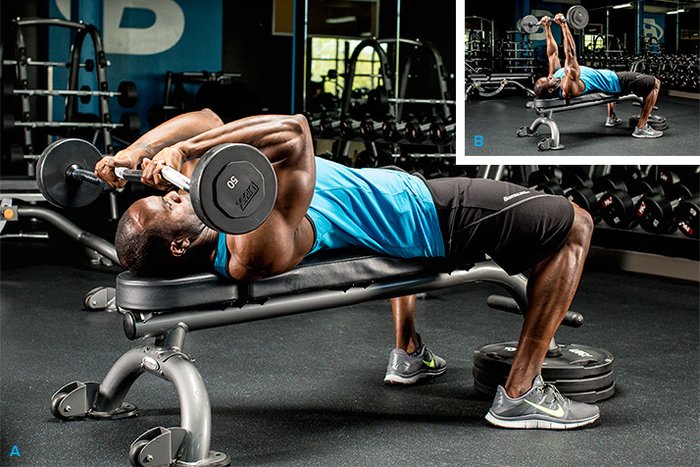
Decline ez-bar skullcrusher
Cable version with bar/EZ-bar
The line of pull comes from the side with this variation, so there's no resting spot at the top.
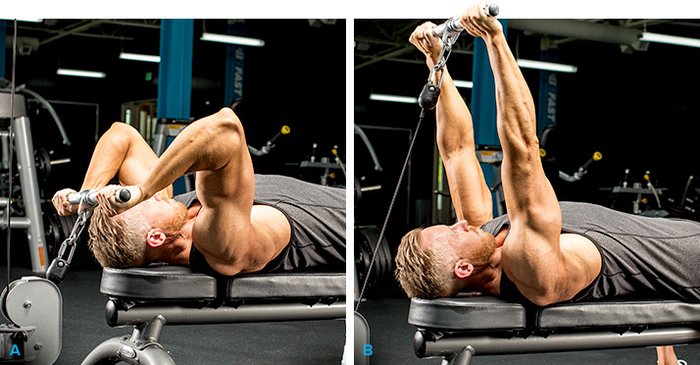
Lying cable skullcrusher
Cable version with rope
A neutral grip on the rope slightly alters how your triceps are recruited, and you can pronate your hands at the end of the range of motion to exaggerate the peak contraction.
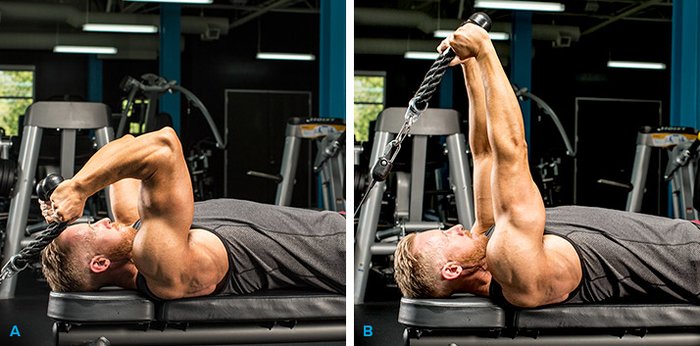
Lying cable skullcrusher with rope attachment
45-Degree
In this variation, your upper arms are angled back toward your head about 45 degrees and locked in that position. This allows the bar to clear the top of your head, and there's no resting spot at the top. You'll also emphasize the triceps long head to a greater degree.
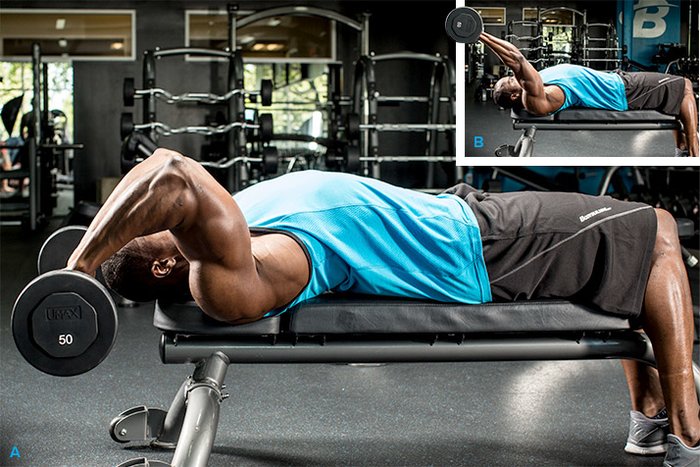
45-degree skullcrusher
Smith machine
Though uncommon, you can do a variation of skulls on the Smith machine. Obviously the bar can't move in an arc, since it's constrained to a vertical pathway, and you'll have to adjust the position of your arms, but you can still move the load primarily with your triceps. If it helps, think of these crushers as a close-grip bench variation.
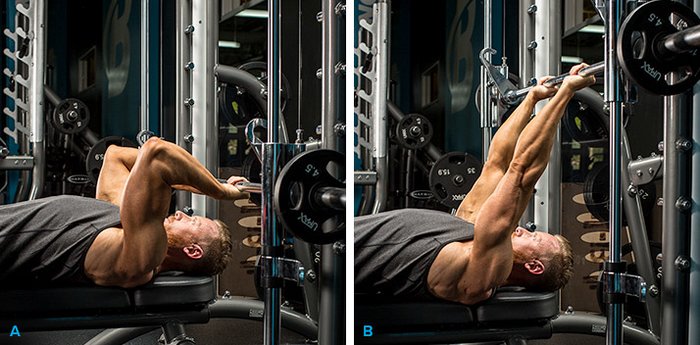
Smith machine skullcrusher
Crush Your Workout
Did You Know?
Skullcrushers and nose breakers refer to the same movement, but there are other names for them too. They're sometimes variously referred to as French presses and lying triceps extensions.
If you're doing any multi-joint exercises in your triceps workout like the triceps dip machine, weighted bench dips, or close-grip bench presses, do those before skullcrushers because you can use the most weight to overload the triceps. Because you can go fairly heavy with skullcrushers, they make a good second exercise in most triceps workouts. Choose a weight you can do for 3 sets of 8-10, but occasionally vary the rep target to prevent stagnation.
Skullcrushing Superset
For a little extra oomph in your next triceps workout, try this superset: Start off with skullcrushers, then immediately proceed to close-grip bench presses. You don't even need to change bars or weight!
The first movement really targets the triceps; do it to failure. Instead of dropping the weight, go right into the multijoint exercise that allows the pecs to help you complete more reps to failure. Just lower the bar to your chest under control and press strongly back upward to full arm extension.
Cheat Crushers
One final tip: You might think that cheating on skullcrushers would send to you to the doctor, but there's a way to keep a set going once you're near muscle failure. Instead of doing the movement strictly—that is, bending and extending at only the elbows—you can allow your upper arms to move back and forth a bit during the exercise execution. While this turns a single-joint movement into a multijoint one—which you normally want to avoid—you can typically squeeze out a few extra reps this way at the end of your workout to really fatigue your triceps.

